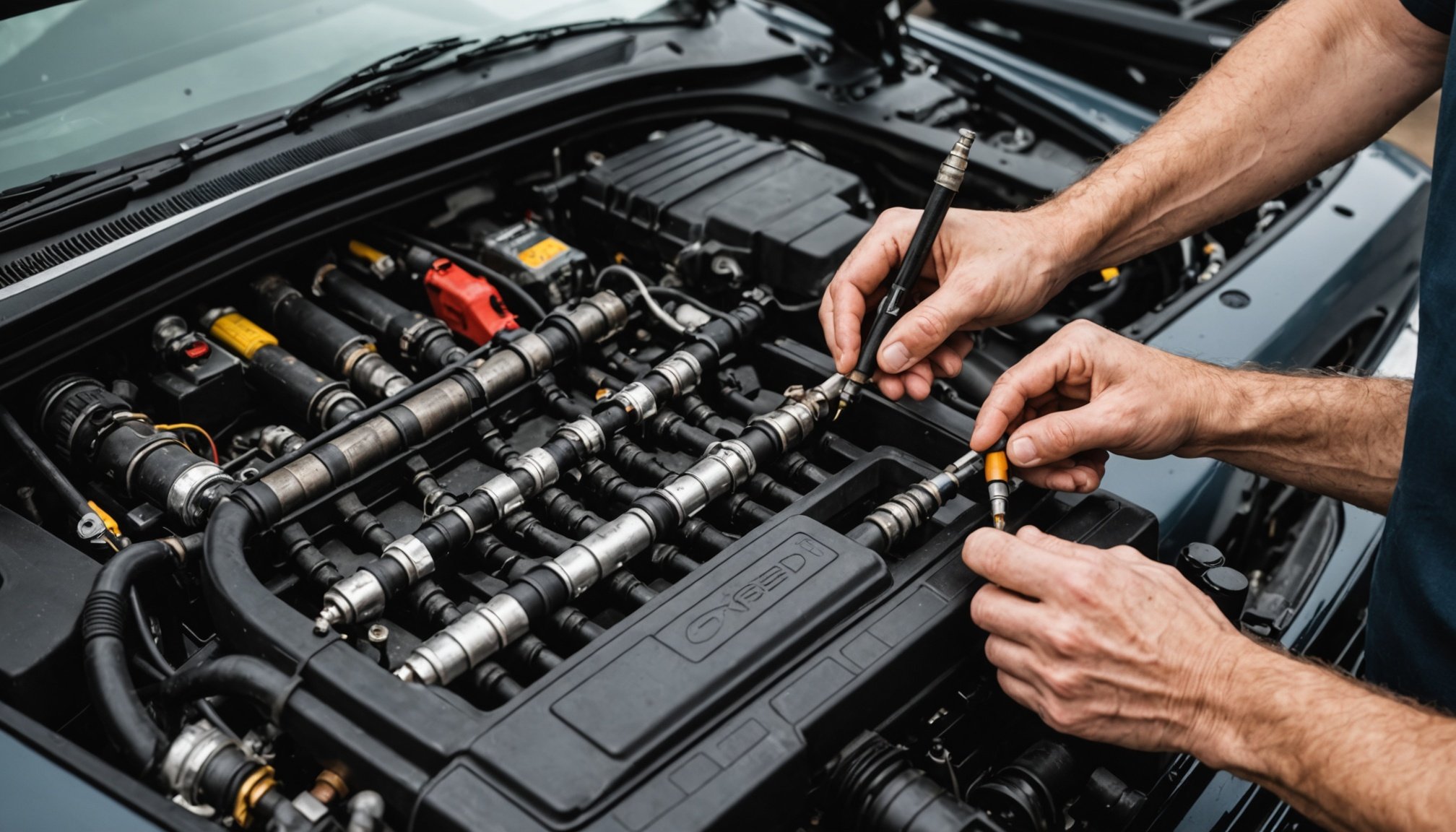Essential tools and preparation for UK fuel injector maintenance
Before beginning DIY fuel injector inspection UK, gathering the right tools is crucial. Common household items often suffice for preliminary checks, including a set of screwdrivers, pliers, and a fuel pressure gauge. For more thorough work, specialized tools for UK cars like injector pullers, multimeters, and cleaning kits may be necessary. Having these at hand ensures a smoother process and prevents mid-task interruptions.
Safety cannot be overstated. When working on fuel systems, always wear protective gloves and goggles to guard against fuel spills and fumes. Ensure the vehicle is on a flat surface with the handbrake engaged to avoid accidental movement. Disconnecting the battery before starting is essential to prevent electrical hazards during injector replacement.
Topic to read : Maximize your uk car’s performance: essential tips for diesel particulate filter maintenance
Preparation involves depressurizing the fuel system carefully by consulting your car’s manual, then removing the engine cover to access injectors. Clean the area around injectors to prevent dirt from entering the fuel rail or cylinders. Taking these steps before you begin not only protects your engine but also simplifies the maintenance task for UK cars.
Step-by-step guide to inspecting fuel injectors in UK cars
Understanding how to inspect fuel injectors UK drivers often face can save both time and money. Start by locating the injectors, typically found on the engine’s intake manifold in most UK car models. A handy tip for any UK car injector DIY enthusiast is to consult your vehicle’s manual to pinpoint injector positions accurately.
Also to discover : Top tips for shielding your car’s upholstery from sun damage in the uk
The first stage is a thorough visual inspection. Look for obvious signs such as fuel leaks around the injector body, cracks in the connectors, or carbon buildup. These visual inspection techniques are crucial in identifying potential faults early. Next, check the electrical connections ensuring they are secure and undamaged.
Functional testing involves listening for injector operation by using a mechanic’s stethoscope or a long screwdriver as a sound conductor—this helps confirm that each injector opens and closes correctly. Symptoms like rough idling, poor acceleration, or high fuel consumption can often be traced back to malfunctioning injectors.
Consistent attention to these visual and functional inspection methods guarantees that UK motorists can diagnose common injector problems before they escalate, improving both vehicle reliability and performance.
How to replace fuel injectors in UK cars with everyday tools
Replacing a fuel injector in the UK can be done effectively with basic car maintenance tools commonly found in most garages. First, safely disconnect the battery to prevent electrical hazards. Remove engine covers to access the injectors, usually needing a ratchet set and screwdrivers. Carefully detach the fuel rail, releasing pressure by loosening the fuel line with a wrench—this step is crucial to avoid fuel spray.
When removing old injectors, gently pull them out, noting their orientation for the DIY injector swap UK. Use a clean cloth to wipe the injector ports to prevent debris contamination. Installing new injectors requires aligning them properly and pressing firmly until they seat—this can be aided by household tools like rubber mallets wrapped in cloth to avoid damage.
After installation, reconnect the fuel rail and battery. Start the engine to check for leaks or misfires. A straightforward way to test successful installation is listening for smooth operation and monitoring the car’s response during a short drive. This method, though basic, ensures your replace fuel injector UK task is done safely and efficiently without specialized tools.
Troubleshooting and avoiding common mistakes in DIY injector work
When tackling fuel injector troubleshooting UK, beginners often face common pitfalls that threaten both performance and safety. One frequent issue is injector swapping errors—mixing up injectors between cylinders can cause rough idling or engine misfires. Always mark each injector clearly before removal to prevent confusion during reinstallation.
Safety mistakes are equally critical. Fuel systems operate under pressure; failing to depressurize the system before inspection can lead to fuel sprays, posing fire risks. Wearing protective gloves and eye gear is essential to avoid injury. Also, improper handling or using incorrect tools can damage sensitive injector components.
Another typical error involves not verifying compatibility with your vehicle’s specifications. This can void warranties or even breach legal regulations in the UK. Always consult your vehicle manual or reliable sources for parts that meet official standards.
For effective fuel injector troubleshooting UK, focus on cleanliness, gentle handling, and methodical reinstallation. If your DIY work faces hesitation, consulting a professional is advised. Proper preparation and awareness reduce errors, ensuring your injector maintenance is both safe and successful.
Maintenance tips and ongoing care for UK car fuel injectors
Taking proper fuel injector care UK seriously can significantly prolong injector lifespan, enhancing your car’s performance and efficiency. Routine maintenance starts with using common tools like fuel system cleaners that you can add directly to the fuel tank. These cleaners help dissolve deposits inside injectors, promoting optimal spray patterns. UK drivers are advised to clean their injectors every 30,000 miles or during major service intervals.
Choosing the right products is crucial; opt for those specifically formulated for UK fuel quality and emission standards to avoid damage. Beyond cleaning, check your injectors visually for early warning signs: uneven engine idling, loss of power, or unusual fuel consumption. Such symptoms often indicate clogging or injector malfunction and warrant prompt professional inspection.
Regular injector maintenance tips include fuel filter replacement before it gets clogged, which protects injectors from debris. Additional care involves timely oil changes, as dirty oil can lead to injector wear. Tracking these practices ensures your car runs smoothly, reduces emissions, and helps you avoid costly repairs related to injector failures.
Fuel injector care UK is not just about cleaning but maintaining the whole fuel system’s health to preserve injector lifespan effectively.



